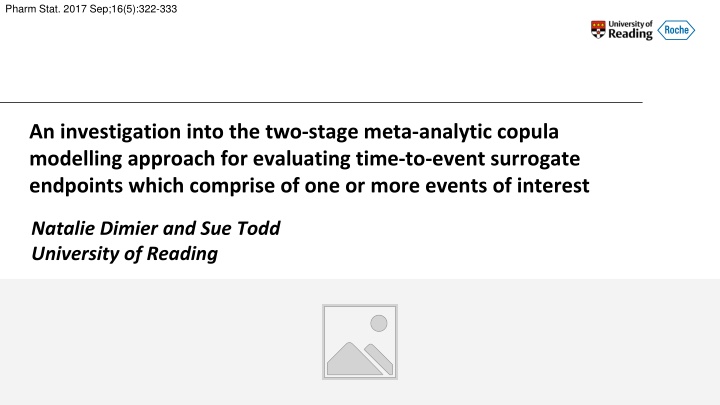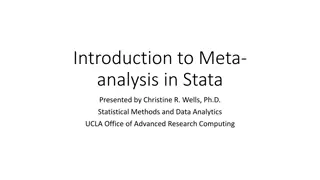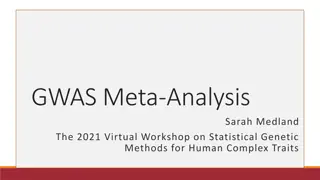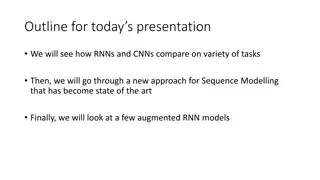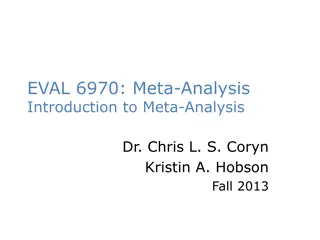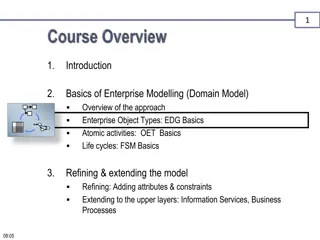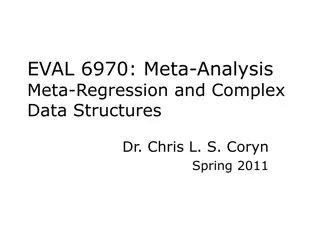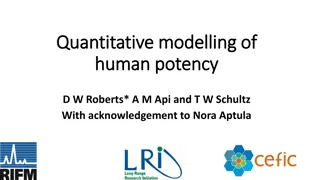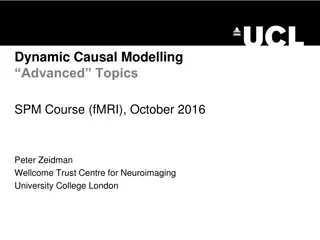Investigation into Two-Stage Meta-Analytic Copula Modelling Approach
Addressing the use of surrogate endpoints in drug development for efficiency and cost reduction, focusing on accurate prediction at individual and trial levels. Recent FDA actions and the need for defining evidentiary criteria are also discussed.
Download Presentation

Please find below an Image/Link to download the presentation.
The content on the website is provided AS IS for your information and personal use only. It may not be sold, licensed, or shared on other websites without obtaining consent from the author.If you encounter any issues during the download, it is possible that the publisher has removed the file from their server.
You are allowed to download the files provided on this website for personal or commercial use, subject to the condition that they are used lawfully. All files are the property of their respective owners.
The content on the website is provided AS IS for your information and personal use only. It may not be sold, licensed, or shared on other websites without obtaining consent from the author.
E N D
Presentation Transcript
Pharm Stat. 2017 Sep;16(5):322-333 An investigation into the two-stage meta-analytic copula modelling approach for evaluating time-to-event surrogate endpoints which comprise of one or more events of interest Natalie Dimier and Sue Todd University of Reading
Agenda Context Motivation for the research Investigation Set-up Results Conclusions Remaining Questions 2
Context: Surrogate Endpoints There is increasing need to improve efficiency in drug development Sample size and expected trial duration driven by choice of primary endpoint Increasing survival times of patients => higher trial costs Public demand for quicker treatment availability Use of surrogate endpoints has been commonly proposed to allow treatments to be developed faster and subsequently made more affordable for payers According to section 507(e)(9) of the Federal Food, Drug, and Cosmetic Act1 [t]he term surrogate endpoint means a marker, such as a laboratory measurement, radiographic image, physical sign, or other measure, that is not itself a direct measurement of clinical benefit, and: (A) is known to predict clinical benefit and could be used to support traditional approval of a drug or biological product; or (B) is reasonably likely to predict clinical benefit and could be used to support the accelerated approval of a drug or biological product in accordance with section 506(c). Therefore need accurate prediction of: Individual-level surrogacy: the ability of the surrogate to predict the true outcome for a patient Trial-level surrogacy: the ability of treatment effect on the surrogate to predict treatment effect on the true outcome 3 1. https://www.fda.gov/Drugs/DevelopmentApprovalProcess/DevelopmentResources/ucm613636.htm
Context: Recent FDA Actions FDA have recognised the need for surrogate endpoints and have taken recent actions to increase their use, including: Publishing a table of all surrogate endpoints used as a basis for regulatory approval Proposing use of Type C meetings to engage with sponsors who would like to employ a biomarker as a surrogate endpoint that has not been used previously Hosting a workshop to develop a framework for defining evidentiary criteria for surrogate endpoints 4 https://www.fda.gov/Drugs/DevelopmentApprovalProcess/DevelopmentResources/ucm613636.htm
Context: Why Meta-Analysis? Original methodology proposed for evaluation of potential surrogate endpoints was based on individual trials Prentice criteria1, proportion of treatment effect explained2, relative effect3, adjusted association3 Meta-analytical approaches subsequently proposed to Increase accuracy of the evaluation process (decrease Type II error and/or improve precision) Assess consistency of the relationship between treatment effects on surrogate and true endpoints across different trials Assess sensitivity of results to key factors, such as treatment class or patient population Improve potential to extrapolate to future clinical trials In practice, trials can vary substantially in their design => many considerations for meta-analysis: Do patient populations need to be identical across trials? Can a common definition of the surrogate endpoint be found? Is it reasonable to pool All types of treatment in the same analysis? All patient subgroups (young/old, newly diagnosed/relapsed, different prognoses)? Any measurement techniques for the surrogate and long-term endpoints? Importantly, how to identify potential trials to be included? 5 1. Stat Med. 1989 Apr;8(4):431-40, 2. Statistics in Medicine, 11, 167 178 (1992), 3. Biometrics. 1998 Sep;54(3):1014-29
Context: Proposed Methodology The work published by Dimier and Todd examined an approach proposed by Burzykowski et al. (2001)1, which assesses surrogacy through parameters of the joint distribution of the surrogate and true endpoints (modelled using a copula function) R2indiv ( ): association between surrogate and true endpoints after adjustment for trial and treatment effects R2trial: coefficient of determination for predicting the effect of treatment on the true endpoint given the effect of treatment on the surrogate Stage One: Estimate treatment effects on the surrogate (S) and true (T) endpoints within each trial, and Estimate association between S and T, adjusting for the trial and treatment effects Stage Two: Fit a random effects model to obtain coefficient of determination between the treatment effects estimated from Stage One 6 1. Applied Statistics, 50:405-422, 2001.
Motivation #1: Small number of trials A sufficient number of trials are needed to reliably explore the relationship between treatment effects on surrogate and true endpoints 1. FLASH 2. ACCENT Extrapolation of results relies on a large amount of data, to capture differences in: Treatment regimen Therapeutic classes of drugs Patient populations or subgroups Recent successful examples have included FLASH1: 3,837 patients from 13 randomised trials ACCENT2 (original database): >20,000 patients from 18 trials SEAL3: 7,507 patients from 13 randomised trials 3. SEAL 4. MRD in CLL Individually, pharmaceutical companies are unlikely to have such substantial data Example4: Evaluation of Minimal Residual Disease as a surrogate for progression-free survival in Chronic Lymphocytic Leukemia using three trials Important to understand whether the methodology performs well with small numbers of trials 7 1. J Clin Oncol. 2017 Feb 10;35(5):552-560; 2. Chin Clin Oncol. 2013 Jun; 2(2): 18; 3. J Clin Oncol. 2018 Jul 5:JCO2018779124; 4. Blood. 2018 Mar 1;131(9):955-962
Motivation #2: Endpoint Symmetry Copula functions make the assumption that S and T are symmetric, i.e. that one cannot be longer than the other Surrogate endpoints that include the true outcome as an event of interest violate this assumption To maximise the number of events, decrease trial durations, and improve clinical relevance of results, endpoints that consider multiple events of interest are commonly used to assess clinical benefit For example, progression-free survival (PFS), defined as time to the earliest of disease progression or death, includes information relating to overall survival PFS commonly used as a surrogate endpoint in oncology Many other endpoints across different diseases will suffer the same limitation Important to understand the impact of this violation on the interpretation of surrogacy results 8
Investigation: Set-up 1. When using a surrogate that includes the event of interest for the true endpoint TTP: time from randomisation to disease progression; censored at death PFS: time from randomisation to disease progression or death; event at death Overall Survival (OS): time from randomisation to death; true endpoint of interest 2. When there are a very small number of trials with very few patients 4-6 trials independently generated, each containing 80-120 patients 3. Under ideal conditions and under model misspecification Use of a copula function can control the strength and shape of dependency between endpoints, but may lead to overly precise estimation of model parameters Two different copula functions used, to evaluate the sensitivity of the estimation to different dependency structures 9
Investigation: Results (Individual-Level Surrogacy) TTP (left hand side): Clayton: Low average relative bias High variability for low medium levels of association, particularly under censoring Clayton Copula Gumbel: Increased variability Underestimation unless censoring is high Truly high association estimated with low variability PFS (right hand side): Gumbel Copula Clayton and Gumbel: Good estimation of truly high association Poor estimation of low association; estimated as high as 0.7 => false conclusion that PFS is predictive of OS Large variability for low association causes overlap between low and medium association levels, hampering interpretation 10 Figure 1 in the paper
Investigation: Results (Trial-Level Surrogacy) Clayton Copula For both TTP and PFS and both copula functions, quite often the case that the true association is over or underestimated Slight trend upwards as the true underlying association increases, but high variability Additional simulations were run for larger samples containing 20 trials of 500 patients, showing that estimation is much improved through inclusion of a larger number of studies with larger sample sizes For trial-level meta analyses of the size investigated here, the method did not allow for clear data interpretation of R2trial and cannot be recommended 11 Figure 2 in the paper
Conclusions Method performed well in estimating individual-level surrogacy for the TTP endpoint, but caution is required when considering endpoints that incorporate information from the true clinical endpoint, such as PFS There is a need for careful selection of both the copula family and the dependence structure, as results can be highly confounded by incorrect assumptions With the limited numbers of trials explored in our study (4-6), the method cannot be considered appropriate for assessing the level to which the treatment effect on the surrogate can predict the unobserved treatment effect on the overall clinical endpoint Testing of larger sample sizes suggested that inclusion of additional data improves estimation It remains uncertain what could be considered a sufficient sample size Complements work of Renfro et al.1 who assess the use of investigational centres as sub-units of trials A large amount of data are not frequently available for individual companies => strongly encourage engagement from industry and academia to collaborate in surrogate endpoint evaluation 12 1. Comput Stat Data Anal. 2014 Oct 1;78:1-20
Remaining Questions What is an acceptable threshold for trial-level surrogacy? Some precedence now for R2trial >0.8 with a lower confidence interval >0.6, but is this appropriate for all disease settings? What is known to predict clinical benefit versus reasonably likely to predict clinical benefit? How to incorporate variability across clinical trials used in the meta-analysis? Even if starting with large meta-analytic database, evaluation of specific treatment regimen, therapeutic classes or patient subgroups can lead to a small sample situation How much extrapolation is justifiable? How much data is enough data? (How) can we split larger trials into multiple units? Some suggestion that six trials is sufficient, but this seems dependent on other factors 13
BACK-UP 14
Copula Model Joins multivariate distribution functions to their uniform marginal distribution functions A function ???,? which, for each pair ? and ?lying in [0,1], generates a number in [0,1] with ???,? = 0 if ? =0 or ?=0 ???,1 = ? and ??1,? = ? ???,? is increasing in both ? and ? ?is the dependence parameter Examples: 1 Clayton: ???,? = (?1 ?+ ?1 ? 1) 1 ? for ?>1 1 ?+ ( log(?)) 1 ?}?] for 0< ?<1 Hougaard: ???,? = exp[ {( log ? ) Choice of copula determines the underlying dependence structure Clayton copula induces late dependence between ? and ? (when marginal survivor functions are assumed) Hougaard copula induces early dependence between ? and ? (when marginal survivor functions are assumed) 15
Doing now what patients need next 16
